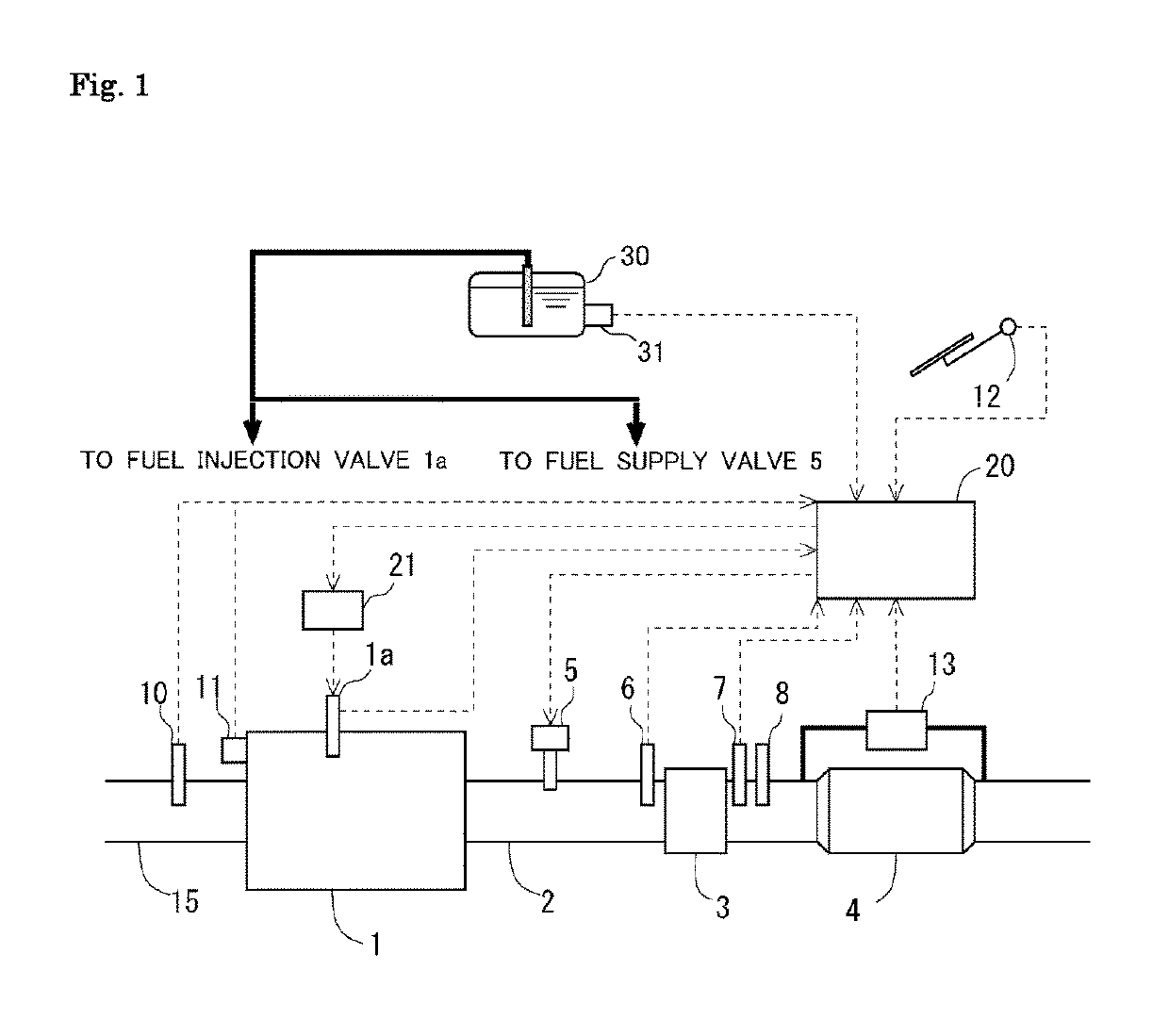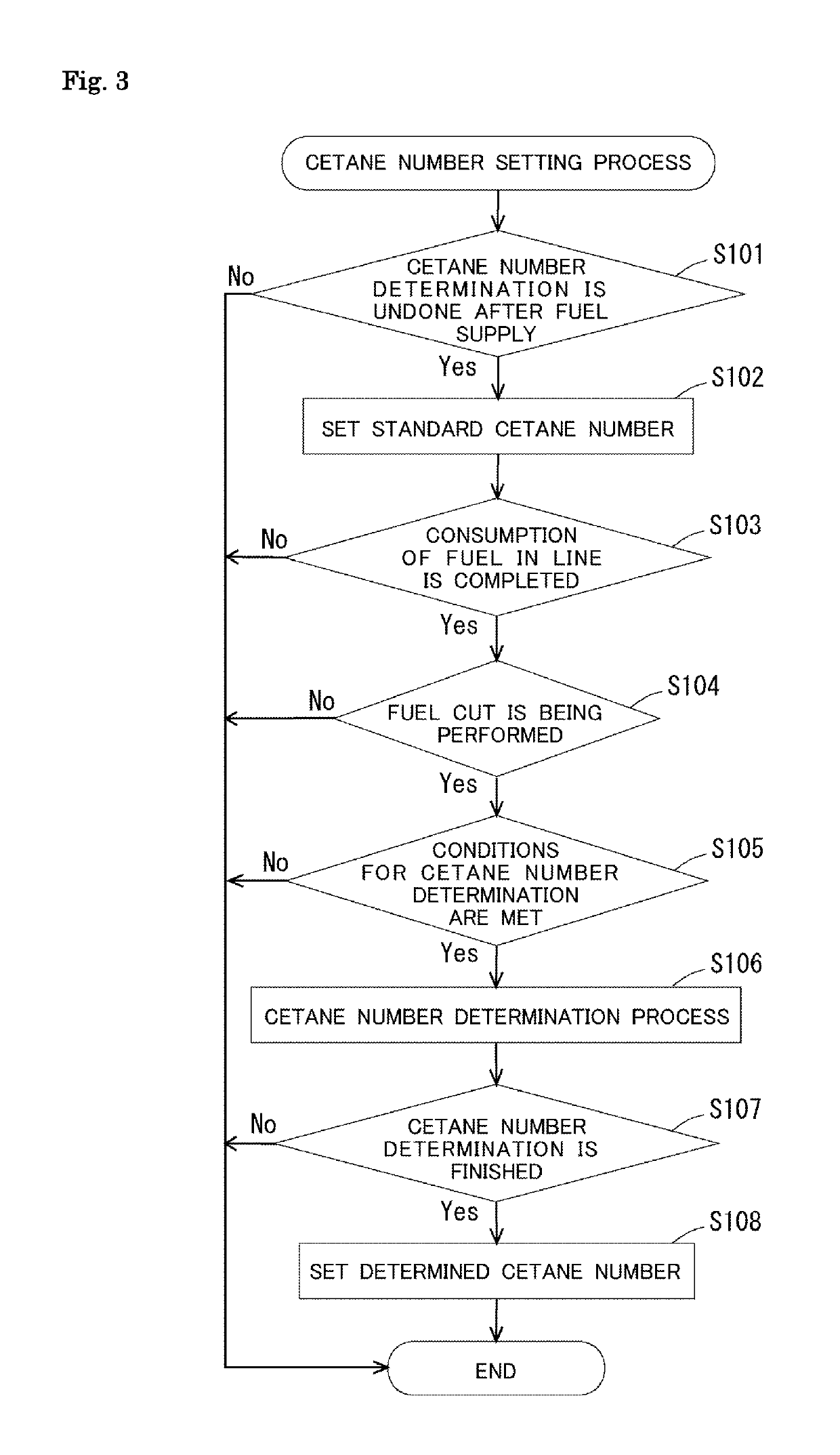Exhaust gas purification system for internal combustion engine
a technology for exhaust gas purification and internal combustion engines, which is applied in the direction of exhaust treatment electric control, electrical control, machines/engines, etc., can solve the problems of inability to meet the requirements of the market, especially volatility, of diesel engine fuel available in the market, and achieve the reduction of nox stored and limited storage capacity of nsr catalysts.
- Summary
- Abstract
- Description
- Claims
- Application Information
AI Technical Summary
Benefits of technology
Problems solved by technology
Method used
Image
Examples
first embodiment
[0034]FIG. 1 shows the general configuration of an exhaust gas purification system for an internal combustion engine 1 according to the present disclosure. The internal combustion engine 1 shown in FIG. 1 is a diesel engine for driving a vehicle. The internal combustion engine operates by burning an air-fuel mixture having a lean air-fuel ratio higher than the theoretical air-fuel ratio. The internal combustion engine 1 is connected with an exhaust passage 2. The exhaust passage 2 is provided with an NSR catalyst 3, which stores NOX contained in the exhaust gas when the exhaust gas has a lean air-fuel ratio and desorbs NOX stored therein to let the desorbed NOX be reduced by unburned fuel in the exhaust gas when the exhaust gas has a rich air fuel-ratio. The exhaust passage 2 is also provided with a particulate filter 4 (which will be simply referred to as the “filter” hereinafter) that traps PM in the exhaust gas, which is arranged downstream of the NSR catalyst 3.
[0035]The exhaust...
second embodiment
[0064]Next, NOX reduction control according to a second embodiment of the present disclosure will be described with reference to flow charts shown in FIGS. 6 and 7. The processing steps in the NOX reduction control shown in FIGS. 6 and 7 that are the same as those in the NOX reduction control shown in FIG. 4 are denoted by the same reference signs and will not be described further.
[0065]In the NOX reduction control shown in FIGS. 6 and 7, the processing of the steps S207 and S208 in the NOX reduction control shown in FIG. 4 is replaced by the processing of steps S401 to S409 in FIG. 7. Specifically, if an affirmative determination is made in step S206, the process proceeds to step S401.
[0066]In step S401, it is determined whether or not the air-fuel ratio of the exhaust gas flowing out of the NSR catalyst 3 measured by the air-fuel ratio sensor 8 is higher than a specific air-fuel ratio Af0, namely whether or not this exhaust gas air-fuel ratio is leaner than the specific air-fuel r...
embodiments
Modification of Embodiments
[0072]In the NOX reduction control according to FIGS. 6 and 7, the processing of steps S401 and S402 relating to the compensation of the quantity of fuel supplied through the fuel supply valve 5 is performed after starting the NOX reduction process and after making the determination as to whether or not reduction of NOX in the NSR catalyst 3 is carried out appropriately (in the processing of step S206). Alternatively, the processing of steps S401 and S402 relating to the compensation of the quantity of fuel supplied through the fuel supply valve 5 may be performed after starting the NOX reduction process but before making the determination as to whether reduction of NOX in the NSR catalyst 3 is carried out appropriately. In this case, the determination as to whether reduction of NOX in the NSR catalyst 3 is carried out appropriately (i.e. the processing of step S206 or S404) is made after confirming the absence of a trouble of the fuel supply valve 5 and p...
PUM
 Login to View More
Login to View More Abstract
Description
Claims
Application Information
 Login to View More
Login to View More - R&D
- Intellectual Property
- Life Sciences
- Materials
- Tech Scout
- Unparalleled Data Quality
- Higher Quality Content
- 60% Fewer Hallucinations
Browse by: Latest US Patents, China's latest patents, Technical Efficacy Thesaurus, Application Domain, Technology Topic, Popular Technical Reports.
© 2025 PatSnap. All rights reserved.Legal|Privacy policy|Modern Slavery Act Transparency Statement|Sitemap|About US| Contact US: help@patsnap.com



